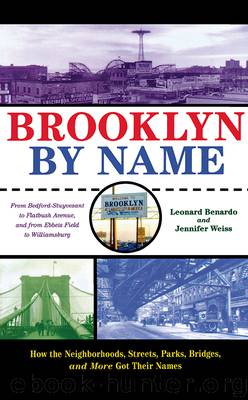Brooklyn by Name by Leonard Benardo & Jennifer Weiss

Author:Leonard Benardo & Jennifer Weiss
Language: eng
Format: epub
Publisher: New York University Press
Published: 2006-03-19T16:00:00+00:00
5 South-Central Brooklyn
Borough Park, Ditmas Park, Flatbush, Kensington, Prospect-Lefferts Gardens, Prospect Park South, Windsor Terrace
A map of South-Central Brooklyn appears on the following pages.
Borough Park, 1970s
Flatbush Street Corner, 1970s
Flatbush was one of Kings County’s six original seventeenth-century towns and for some time the largest. Geographically central, from 1683 it was the county’s original seat of government. Known officially as Midwout, or “Middle-Woods,” by the Dutch, it also carried the name V’Lacke Bos, “wooded plain,” reflecting the abundance of land covered in heavy timber and contrasting with its neighbor to the south, Flatlands, which was flat and clear of woods. V’Lacke Bos was anglicized to Flatbush after the British takeover in 1664.
In 1898 Dean Alvord (1857-1941) purchased forty acres of land in Flat-bush’s northwest corner from the Flatbush Dutch Reformed Church and the farm of John C. Bergen, aspiring to create an ideal concept of the rus in urbe. Seeking to model the new community, Prospect Park South, on Boston’s Commonwealth Avenue, Alvord deliberately selected Anglo names for the streets (Albemarle, Argyle, Buckingham, Marlborough, Rugby, Stratford, Westminster), a pose also influenced by his desire to recruit “people of intelligence and good breeding.” These street names illustrate the quantum shift from anti-Anglo sentiment after the Revolutionary War to Anglophilia one century later. Prospect Park South soon became a model for other planned residential communities nearby.
Kensington, named for the western borough of London, developed coterminously with Prospect Park South at the end of the nineteenth century. But there were distinct differences in how the neighborhoods were built up: the majority of Kensington’s housing—one-family Victorians, rowhouses, and six-story apartment buildings—was not constructed until the 1920s, and unlike Prospect Park South, Kensington experienced a great influx of diverse immigration.
South of Kensington lies Ditmas Park, a landmark district broadly planned—from streets to sidewalks to landscapes—by developer Lewis Pounds and architect Arlington Isham. It is named for the son of family patriarch Jan Jansen van Ditmarsum of the Duchy of Holstein, Denmark, who immigrated to Flatbush in the mid-seventeenth century.
Further west, Electus B. Litchfield, son of developer and railroad magnate Edwin C. Litchfield, established Blythebourne (“happy home” in Scottish) from the former farmland of the Lotts, Kouwenhovens, and Bergens. Litchfield named it after his ancestral estate in Scotland. State senator William Reynolds, an owner of the Brooklyn Bath and West End Railroad, which steamed through the area, expanded Litchfield’s settlement (the name Blythebourne soon drifting into obsolescence) and is credited with coining the name Borough Park.
The terrain that became Windsor Terrace, named for Windsor, England, was farmland owned by John Vanderbilt, and it is believed that English settlers in the area provided the neighborhood with its name. Directly across the park at the northern tip of Flatbush lies Prospect-Lefferts Gardens, a residential district whose name alludes to the Lefferts Manor that lies within it—six hundred lots developed by James Lefferts in 1893 using the family’s land holdings—as well as to Prospect Park and the Brooklyn Botanic Garden.
Similar to other Kings County towns, antebellum Flatbush was replete with
Download
This site does not store any files on its server. We only index and link to content provided by other sites. Please contact the content providers to delete copyright contents if any and email us, we'll remove relevant links or contents immediately.
Steinbrenner by Bill Madden(777)
Uncle John's Bathroom Reader Plunges into New York by Bathroom Readers' Institute(643)
New Jersey Noir by Joyce Carol Oates(569)
Fodor's New York City (Full-color Travel Guide) by Fodor's Travel Guides(516)
Fodor's New York City 2016 by Fodor's Travel Guides(511)
Northeast Medicinal Plants by Liz Neves(498)
Long Island Noir by Kaylie Jones(482)
Manhattan Noir 2 by Lawrence Block(471)
Battle on the Hudson by Tim Sullivan(457)
Manhattan Noir by Lawrence Block(440)
Fodor's New York City 2020 by Fodor's Travel Guides(434)
Beyond Broadway Joe by Bob Lederer(427)
One-Track Mind by Philip Ashforth Coppola(420)
Haunted Ohio by Charles A. Stansfield Jr(416)
Field Guide to the Natural World of New York City by Leslie Day(413)
Minimal New York City by Michael Arndt(413)
Wall Street Noir by Peter Spiegelman(407)
Ben Franklin's Philadelphia by Tom Huntington(376)
My Wild Ride in Baseball and Beyond by Davey Johnson & Erik Sherman(364)
